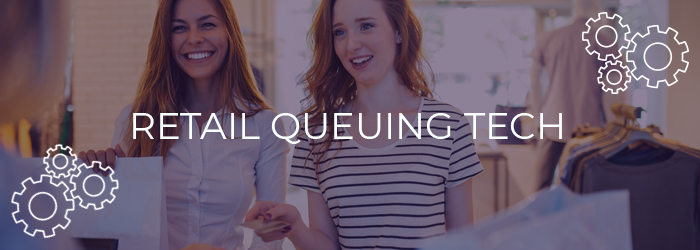
5 Ways Retail Queuing Tech is Keeping Brick-and-Mortar in the Game
Despite what many reports would have you think, brick-and-mortar retail isn’t dead. But it is evolving. Perhaps even dramatically. Look no further than Amazon Go for a clear indicator of this evolution. But whether your retail business is going for a dramatic evolution, or simply looking for ways to stay relevant and profitable in today’s digital world, one area every brick-and-mortar must contend with is its waiting lines.
According to the customer experience management company, ICC/Decision Services, one of the biggest negatives of brick-and-mortar shopping in the minds of consumers is the waiting lines. Whether waiting for help from an associate, waiting for a fitting room, or waiting to checkout--consumers just hate to wait.
So whether your aim is to eliminate the lines completely as Amazon Go is attempting to do, or to ensure they operate at a level that keep customers satisfied and profits high, the fact remains: queuing matters.
Enter queuing technology.
From virtual queuing and call-forward systems, to footfall analytics and mobile queuing, technology is being applied to better manage all sorts of retail queues. Here are five ways retail queuing technology is helping to keep brick-and-mortar alive and well:
1. Giving managers a real-time view of queuing KPIs
Today’s footfall analytics technology is putting KPIs directly into the hands of managers, providing the kind of real-time vision you would think only possible in a digital environment. These important KPIs--including wait times, arrivals, and service rates-- keep managers ahead of the queuing game by using text messages and/or emails to notify them immediately when there is a problem in the making.
2. Optimizing BOPUS
Buy online, pick-up in store (a.k.a. BOPUS) is an increasing trend. But what happens when consumers go to the store to pick up their items? Retail tech in the form of mobile queuing systems are helping retailers turn the BOPUS trend into a real advantage, optimizing the in-store pickup experience by giving customers the opportunity to avoid the waiting line when they arrive in-store to claim their goods. Two-way texting via mobile queuing allows the retailer to notify the customer when their order is ready and for the customer to alert the retailer when they have arrived at the store. And since the queue is virtual, there’s no physical waiting line to bog down the process or create frustration among shoppers who expect little if any wait time to pick up their order.
3. Streamlining self-checkout
The promise of self-checkout queues is to reduce wait times and optimize efficiency. Instead, many retailers have found customers waiting longer than expected and sometimes encountering confusing or chaotic waiting lines. Retail tech has come to the rescue by offering a practical solution. Utilizing a single line queue, an automated call-forward system automatically directs customers to the next available service station using audio and visual cues. The system uses sensors to detect when a station is free and helps eliminate delays that, over time, add up to longer wait times.
4. Empowering store associates
Customer experience is about more than just customers...it’s also about the store associate experience. When retailers empower their store associates to be more efficient, productive, and engaging with customers, they can immediately impact the customer experience. Retail tech is helping empower store associates by helping them better align with demand and allowing associates to quickly see how many people are waiting in line and how long they are expected to wait. By empowering store associates in this way (via a mobile device), retailers are able to impact the customer experience and become more efficient.
5. Dispersing waiting lines
Sometimes the best waiting line is no waiting line at all. Consider the example of dressing rooms. Nothing can make a shopper renege on a potential purchase faster than to see a long line at the dressing room. Virtual queuing technology, assisted by a dressing room host, can keep shoppers doing what they love (shopping) while they wait in a virtual line for their turn in the dressing room. This same technology can be used throughout the retail environment wherever customers must wait for personalized help or service (think: jewelry or makeup counters, technology purchases, etc.).
A recent TimeTrade State of Retail Report found that most consumers (85%) would prefer to shop in stores because they like to touch and feel products before they make a purchase decision. More than one third (36%) of the survey’s respondents said they don’t like waiting for items to ship and 30% appreciate getting advice from store associates on what products they should purchase.
For these reasons and more, brick-and-mortar retail isn’t dead. It’s evolving. Are you?
Visit us at NRF 2019 Booth #2381 to see queuing technology in action!
SUBSCRIBE
Subscribe to stay up-to-date with new products, resources information and news.
RECENT RESOURCES
From Bleachers To Bookstores: 4 Campus Crowd Control Solutions
ViewCrowd Control Systems for Large Venues
ViewWrigley Field Case Study: Just Walk Out Technology
ViewClip-Mounted Acrylic Sign Holders
View








